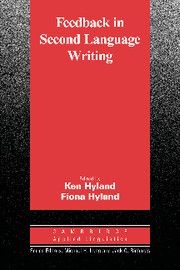Book contents
- Frontmatter
- Contents
- Contributors
- Series editors' preface
- Preface
- Chapter 1 Contexts and issues in feedback on L2 writing: An introduction
- I SITUATING FEEDBACK: SOCIOCULTURAL DIMENSIONS
- II SHAPING FEEDBACK: DELIVERY AND FOCUS DIMENSIONS
- III NEGOTIATING FEEDBACK: INTERPERSONAL AND INTERACTIONAL DIMENSIONS
- Chapter 10 Feedback and revision in second language writing: Contextual, teacher, and student variables
- Chapter 11 Interpersonal aspects of response: Constructing and interpreting teacher written feedback
- Chapter 12 Formative interaction in electronic written exchanges: Fostering feedback dialogue
- Chapter 13 Scaffolded feedback: Tutorial conversations with advanced L2 writers
- Chapter 14 “You cannot ignore”: L2 graduate students' response to discipline-based written feedback
- Author index
- Subject index
Chapter 10 - Feedback and revision in second language writing: Contextual, teacher, and student variables
Published online by Cambridge University Press: 05 October 2012
- Frontmatter
- Contents
- Contributors
- Series editors' preface
- Preface
- Chapter 1 Contexts and issues in feedback on L2 writing: An introduction
- I SITUATING FEEDBACK: SOCIOCULTURAL DIMENSIONS
- II SHAPING FEEDBACK: DELIVERY AND FOCUS DIMENSIONS
- III NEGOTIATING FEEDBACK: INTERPERSONAL AND INTERACTIONAL DIMENSIONS
- Chapter 10 Feedback and revision in second language writing: Contextual, teacher, and student variables
- Chapter 11 Interpersonal aspects of response: Constructing and interpreting teacher written feedback
- Chapter 12 Formative interaction in electronic written exchanges: Fostering feedback dialogue
- Chapter 13 Scaffolded feedback: Tutorial conversations with advanced L2 writers
- Chapter 14 “You cannot ignore”: L2 graduate students' response to discipline-based written feedback
- Author index
- Subject index
Summary
Teachers of second language writers often mention their concerns regarding the most effective means for providing feedback on text-level issues (content and rhetoric) to help students improve their texts in both the immediate sense and the long term. Over the past 20 years, beginning with Vivian Zamel's 1985 study examining the feedback practices of a small group of ESL teachers, a small body of research has developed addressing issues pertaining to teacher feedback and revision at the text level. In reviewing this body of literature, I have noted that “the research has largely been noncontextual and nonsocial, focused largely on texts and conducted within a linear model of teacher respond and student revise … however there are a good many factors that probably play an interactive role in how teachers comment, how students perceive and react to teacher commentary, and how students use such commentary when revising” (Goldstein, 2001, p. 77).
In Goldstein (2004), I argue for the need to take into account how contextual factors, as well as individual teacher and student factors, can influence teacher commentary and student revision. Contextual factors can include (1) sociopolitical issues that influence teacher status, the number of classes teachers need to teach, and the number of institutions at which teachers need to teach in order to make a living, resources available to students to ensure their success, and class size; (2) program and institutional attitudes toward second language writers; (3) program and curricular requirements; (4) program philosophies about the nature of effective feedback; and (5) entrance and exit requirements.
Information
- Type
- Chapter
- Information
- Feedback in Second Language WritingContexts and Issues, pp. 185 - 205Publisher: Cambridge University PressPrint publication year: 2006
Accessibility standard: Unknown
Why this information is here
This section outlines the accessibility features of this content - including support for screen readers, full keyboard navigation and high-contrast display options. This may not be relevant for you.Accessibility Information
- 44
- Cited by
